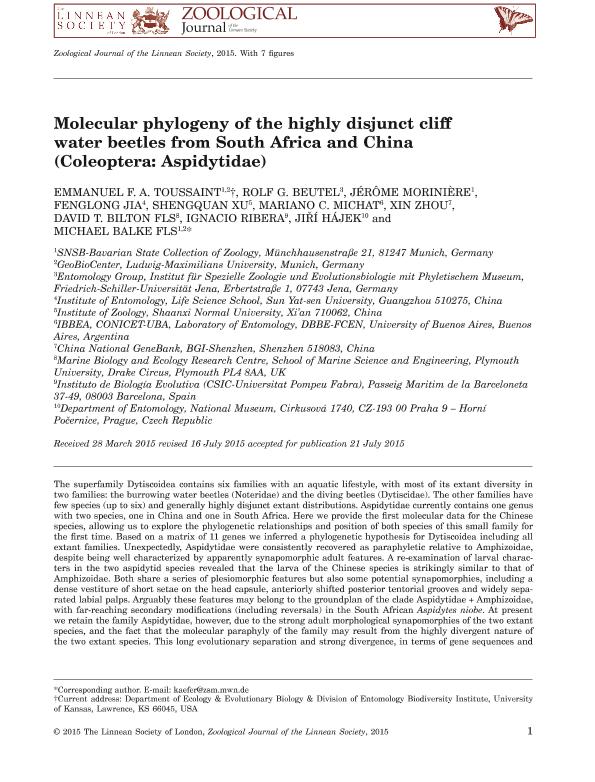Mostrar el registro sencillo del ítem
dc.contributor.author
Toussaint, Emmanuel F.A.
dc.contributor.author
Beutel, Rolf G.
dc.contributor.author
Morinière, Jérôme
dc.contributor.author
Jia, Fenglong
dc.contributor.author
Xu, Shengquan
dc.contributor.author
Michat, Mariano Cruz

dc.contributor.author
Zhou, Xin
dc.contributor.author
Bilton, David T.
dc.contributor.author
Ribera, Ignacio
dc.contributor.author
Hájek, Ji?í

dc.contributor.author
Balke, Michael

dc.date.available
2018-09-20T13:49:31Z
dc.date.issued
2016-03
dc.identifier.citation
Toussaint, Emmanuel F.A.; Beutel, Rolf G.; Morinière, Jérôme; Jia, Fenglong; Xu, Shengquan; et al.; Molecular phylogeny of the highly disjunct cliff water beetles from South Africa and China (Coleoptera: Aspidytidae); Wiley Blackwell Publishing, Inc; Zoological Journal of the Linnean Society; 176; 3; 3-2016; 537-546
dc.identifier.issn
0024-4082
dc.identifier.uri
http://hdl.handle.net/11336/60381
dc.description.abstract
The superfamily Dytiscoidea contains six families with an aquatic lifestyle, with most of its extant diversity in two families: the burrowing water beetles (Noteridae) and the diving beetles (Dytiscidae). The other families have few species (up to six) and generally highly disjunct extant distributions. Aspidytidae currently contains one genus with two species, one in China and one in South Africa. Here we provide the first molecular data for the Chinese species, allowing us to explore the phylogenetic relationships and position of both species of this small family for the first time. Based on a matrix of 11 genes we inferred a phylogenetic hypothesis for Dytiscoidea including all extant families. Unexpectedly, Aspidytidae were consistently recovered as paraphyletic relative to Amphizoidae, despite being well characterized by apparently synapomorphic adult features. A re-examination of larval characters in the two aspidytid species revealed that the larva of the Chinese species is strikingly similar to that of Amphizoidae. Both share a series of plesiomorphic features but also some potential synapomorphies, including a dense vestiture of short setae on the head capsule, anteriorly shifted posterior tentorial grooves and widely separated labial palps. Arguably these features may belong to the groundplan of the clade Aspidytidae+Amphizoidae, with far-reaching secondary modifications (including reversals) in the South African Aspidytes niobe. At present we retain the family Aspidytidae, however, due to the strong adult morphological synapomorphies of the two extant species, and the fact that the molecular paraphyly of the family may result from the highly divergent nature of the two extant species. This long evolutionary separation and strong divergence, in terms of gene sequences and larval features, is undeniable, substantial levels of saturation in third codon positions of protein-coding genes being present between the two taxa. We address this issue taxonomically by introducing the new genus Sinaspidytes gen. nov. for the Chinese Aspidytes wrasei. The continued contentious relationships amongst Dytiscidae, Hygrobiidae, Aspidytidae and Amphizoidae highlight the need for more data to address dytiscoid phylogenetics, possibly involving a genomic approach.
dc.format
application/pdf
dc.language.iso
eng
dc.publisher
Wiley Blackwell Publishing, Inc

dc.rights
info:eu-repo/semantics/openAccess
dc.rights.uri
https://creativecommons.org/licenses/by-nc-sa/2.5/ar/
dc.subject
Aquatic Adephaga
dc.subject
Aspidytes
dc.subject
Dytiscoidea
dc.subject
Sinaspidytes Gen. Nov
dc.subject.classification
Otras Ciencias Biológicas

dc.subject.classification
Ciencias Biológicas

dc.subject.classification
CIENCIAS NATURALES Y EXACTAS

dc.title
Molecular phylogeny of the highly disjunct cliff water beetles from South Africa and China (Coleoptera: Aspidytidae)
dc.type
info:eu-repo/semantics/article
dc.type
info:ar-repo/semantics/artículo
dc.type
info:eu-repo/semantics/publishedVersion
dc.date.updated
2018-09-05T15:13:37Z
dc.journal.volume
176
dc.journal.number
3
dc.journal.pagination
537-546
dc.journal.pais
Reino Unido

dc.journal.ciudad
Londres
dc.description.fil
Fil: Toussaint, Emmanuel F.A.. Bavarian State Collection of Zoology; Alemania. Ludwig-Maximilians University; Alemania
dc.description.fil
Fil: Beutel, Rolf G.. Institut für Spezielle Zoologie und Evolutionsbiologie mit Phyletischem Museum; Alemania
dc.description.fil
Fil: Morinière, Jérôme. Bavarian State Collection of Zoology; Alemania
dc.description.fil
Fil: Jia, Fenglong. Sun Yat-sen University; China
dc.description.fil
Fil: Xu, Shengquan. Shaanxi Normal University; China
dc.description.fil
Fil: Michat, Mariano Cruz. Consejo Nacional de Investigaciones Científicas y Técnicas. Oficina de Coordinación Administrativa Ciudad Universitaria. Instituto de Biodiversidad y Biología Experimental y Aplicada. Universidad de Buenos Aires. Facultad de Ciencias Exactas y Naturales. Instituto de Biodiversidad y Biología Experimental y Aplicada; Argentina
dc.description.fil
Fil: Zhou, Xin. China National GeneBank; China
dc.description.fil
Fil: Bilton, David T.. Plymouth University; Reino Unido
dc.description.fil
Fil: Ribera, Ignacio. Consejo Superior de Investigaciones Científicas; España. Universitat Pompeu Fabra; España
dc.description.fil
Fil: Hájek, Ji?í. National Museum; República Centroafricana
dc.description.fil
Fil: Balke, Michael. Bavarian State Collection of Zoology; Alemania. Ludwig-Maximilians University; Alemania
dc.journal.title
Zoological Journal of the Linnean Society

dc.relation.alternativeid
info:eu-repo/semantics/altIdentifier/doi/https://dx.doi.org/10.1111/zoj.12332
dc.relation.alternativeid
info:eu-repo/semantics/altIdentifier/url/https://academic.oup.com/zoolinnean/article/176/3/537/2453139
Archivos asociados
